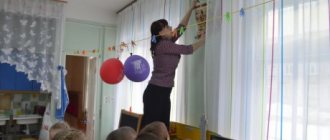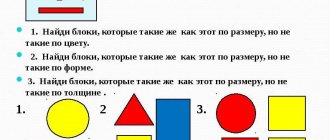Goals and objectives of conducting outdoor games with children
For the children of the second junior group, it is very important that the fun used in classes and at leisure be mobile to varying degrees. Only in this case, gaming activity allows you to achieve your goals, namely:
- promotes the comprehensive development of pupils (physical, emotional and volitional);
- improves health (musculoskeletal, cardiovascular, respiratory systems);
- develops the skill to follow the terms of the game;
- stimulates the desire to interact with adults and children;
- fosters the need to feel part of a team.
To achieve these goals during the game, it is necessary to systematically and consistently solve problems such as:
- mastering the skill of performing motor exercises of varying degrees of complexity together with friends and/or a teacher;
- practicing the skills learned last year to run, walk at different speeds, throw and catch a ball, long and high jump;
In the second younger group, games play an educational role, in particular they instill a sense of camaraderie
- improving the skill of giving movements characteristic features through imitation (for example, flapping their wings like a bird, moving smoothly like a cat, etc.);
- continuation of work on exercises for orientation in space, performing actions according to the conventional sign given to the driver;
- learning to coordinate your actions with the course of the plot and the conditions of the fun, as well as to correlate your movements with the movements of your comrades;
- encouraging initiative.
Tasks set during classes
In outdoor games with a ball, preschoolers acquire the necessary skills and abilities. Children learn to clearly and calmly perform the exercises given by the teacher. Develops manual dexterity and improves physical fitness.
| № | Action | Skills children need to acquire |
| 1 | Pushing and rolling | vigorous pushing with hands, rolling between objects |
| 2 | Catching | catching with hands without pressing to the chest; catching with subsequent passing to each other |
| 3 | Reception | reception with both hands at the same time |
| 4 | Throwing and passing | two-handed throws throws to a clearly defined location transmission from the chest, from behind the head, from below |
| 5 | Batting | vigorous beating with hands |
The children also get acquainted with the properties of the ball itself: volume, shape, dynamics. Training must be done with both large and small balls.
Methods of working with children
Individual work is needed with children who were unable to complete the exercises. The development of motor skills occurs most effectively while playing with a ball in kindergarten. Attention to each individual child is an integral part of the correct upbringing process.
Lengthy explanations during play are poorly received by preschoolers, and therefore it is better to use short comments. It is recommended to celebrate achievements and successes in front of the whole group.
Children participating in throwing games should be taught that:
- you need to be careful when fishing,
- do not throw at the head and feet area,
- It’s worth calculating your strength to avoid injuries to other guys.
Interest in games largely depends on the teacher. Criticism and comments should not be presented in a form that will reduce interest in the exercises.
Time plan and game execution
In the second younger group, the game lasts up to 10 minutes and includes working through five stages.
- Introductory stage up to 1 minute. The teacher announces the name of the game, motivates and briefly describes the main actions (“We will run/climb/jump”, etc.).
- Familiarization with the rules. The teacher describes in detail the actions of each participant in the plot (2 minutes).
- Game up to 5 minutes.
- Complicating conditions (1 minute). For example, the teacher relieves himself of his powers as a driver and transfers them to the child. The first 2-3 times this step is skipped.
The complexity of the rules takes into account the characteristics of the group’s level of development, and may even be omitted altogether.
- The final stage (reflection) – 1 minute. The teacher thanks the children for the game, praising their speed, dexterity and desire to help a friend.
Table: example of a summary of the outdoor game “Wolf and Hare” in the second junior group
Author - Krasavina M.K., teacher of MBDOU DSKV No. 17 “Ladushki”, Nizhnevartovsk, Khanty-Mansiysk Autonomous Okrug.
| Stage | Content |
| Introductory | Educator: Guys, look, a bunny came to visit us. He's not happy. Let's ask the bunny what happened? The teacher asks the bunny what happened, why is he sad and cheerless? Educator: Guys, the bunny told me that he has no friends and has no one to play with. Let's make friends with the bunny and play. The bunny loves to play the game “Wolf and Hares.” You and I know this game. Let's remember the rules of the game, what not to do? Children's answers (you can't shout or push while playing) |
| Introduction to the rules | Each bunny will have its own house, this is a chair. Children-hares sit on chairs. There is a wolf to the side. Hares run out into the clearing, jump, nibble grass, and frolic. At the teacher’s signal: “The wolf is coming!” - the hares run away and sit on a chair. The wolf is trying to catch up with them. The game uses the text: Bunnies are jumping: skok, skok, skok, To the green meadow. They pinch the grass, eat it, listen carefully, is a wolf coming? |
| A game | Children perform the actions described in the poem. With the end of the text, a wolf appears and begins to catch hares. Instructions for carrying out. The child playing the role of the wolf should be away from the place where the children are sitting. Then the child, playing the role of a wolf, runs out and catches the children - bunnies. (the game is repeated several times). |
| Complication | We place the wolf closer to the hare children. |
| The final stage | Guys, look, the bunny has become cheerful, he liked playing with you, but it’s time for him to return to his forest. Did you guys like the game? Well done! |
Video: outdoor game “Shaggy Dog” in the second junior group
Video: outdoor game “We stomp our feet”
Classification of outdoor games
The variety of tasks for conducting this type of fun makes it necessary to systematize outdoor games by type, namely:
- to develop the ability to run and jump (it is difficult for younger preschoolers to coordinate their movements, in particular, to move in one direction);
- for orientation in space;
- to develop balance (for example, in games of walking on a limited surface to rhythmic lines);
- to strengthen the muscles of the torso, back, spine, arch of the foot;
- for imitation;
In imitation games, children not only try to repeat the movements of animals and adults, but also imitate different sounds.
- with a ball (including for the formation of partnerships between children);
- to master the skill of climbing;
- on the development of attention.
Based on their place in the educational process, games for children aged 1.5–3 years can be divided into four types:
- fun for a walk (carried out on the street);
- physical education breaks (organized during classes for relaxation and change of activities);
- leisure activity (for spending time outside of classes - on a walk, at matinees, in the process of independent activities);
In the warm season, outdoor games are the main activity during a walk.
- folk game (to get acquainted with the traditions and customs of your people).
Based on the types, we can conclude that outdoor activities are carried out at every lesson not only in the form of a physical education break, but also in separate lessons: physical education, choreography (if this discipline is included in the preschool educational program), music class.
Card index of outdoor games for the development of various skills
If didactic games are conducted according to the principle of compliance with the lexical topic, then outdoor fun is grouped by:
- physical skill being practiced;
- the totality of implementation of the assigned tasks in one complex;
- topic (the principle is similar for didactic games).
In this case, it is necessary to take into account the fact that the last principle is the least productive, since the plots of outdoor games can easily be transformed from one lexical topic to another. For example, the fun “Hen and Chicks” when working with the topic “Pets” can easily become “Penguin and the Little Penguins” when working with the topic “Animals of the North”.
On the street, you should try to choose games in which it is possible to beat the objects of the sports ground
The most convenient and universal classification is based on the principle of the skill being practiced.
Running, jumping
- "Aircraft". With the help of this game, children practice running in different directions without colliding with partners, learn to listen carefully to instructions, and also quickly react to a signal to change the nature of the movement. Conditions: the teacher shows movements simulating the readiness of an airplane for flight, starting the engine (rotational movements of the arms in front of you while pronouncing the sound “R-r-r”), flight (running with arms spread to the sides) and “landing” for landing (on a bench ). Children repeat the entire complex, listening to the teacher’s instructions.
- "Sun and Rain." The goals of the game are similar to those described in the previous game. Conditions: the teacher marks a line on the playground beyond which children squat. At the signal: “The sun is in the sky, you can go for a walk,” children run around the playground. After the words: “Rain!” urgently return to their places.
In the second younger group, the main element of games is running, jumping is rarely included
Orientation in space
- "Sparrows and a car." This game helps children practice running in different directions, the skill of starting and changing movements at the driver's signal. Conditions: children are “sparrows” who sit on a bench “in a nest”. An adult imitates a car. At the words: “Fly, sparrows,” the kids run away, and at the signal: “The car is moving, everyone fly to the nest!”, they quickly run to their places on the bench.
- “The Bird and the Chicks” (“The Hen and the Chicks”). Goals: coordinate your movements with the words of the driver, learn to run in all directions without catching each other. Conditions: the driver appoints himself a “bird”, gathers the “chicks” - all the guys - around him within the boundaries of a drawn circle. At a signal, the kids run away from the circle and return back at the same signal. As a variant of the same game actions, you can play the game “Find your house” or “Birdhouses”. The conditions of the latter are a little more complicated: all children are appointed starlings, but nests are drawn for only half of the participants, so whoever did not manage to take their place at the signal is considered a loser.
- "Shaggy Dog." To the goals already identified in previous games of this group, one more is added: not to get caught by the catcher. Conditions: on one side of the site there is a “dog”, on the other there are children sneaking towards him. The teacher illustrates this movement by saying that the dog is lying quietly, but what will happen if you wake it up. And then the “dog” wakes up and starts barking. The children return to their seats, and the dog tries to grab them along the way. Anyone who fails to escape becomes a dog.
Outdoor games can be supplemented with elementary costumes or masks
Developing a sense of balance
- “I’m holding a handkerchief.” Goals: to train balance and practice the skill of performing movements on a signal. Conditions: kids place a scarf on their hand (or other part of the body) and, performing different movements, hold it in its original position.
- "We're parking the car." Goal: practice walking forward with your back. The teacher invites all children to become cars that need to be parked. To do this, each child, following the driver’s instructions regarding the direction of movement (“left”, “right”, “turn”), parks the “car”.
Imitation skill
- "Bubble". The game encourages children to act in accordance with the words of the plot, teaches them to coordinate their movements with the movements of other participants, develops imitation skills and encourages children’s initiative. Conditions: the teacher and children, holding hands, make a circle. Then the leader says 2-3 times: “Inflate, bubble, but don’t burst,” the round dance participants disperse wider and wider, and in response to the words: “The bubble has burst!” children open their hands, pronouncing the sound: “Sh-sh-sh.”
- "Vaska the cat." The goals of this game are identical to the previous one. A child cat walks around the playground, purring. Kittens are playing around nearby. And so Vaska falls asleep, the kids run to him, accidentally wake him up, and then run off to their “houses” - their chairs.
- "Legs." The purpose of this game is to practice the skill of repeating the actions of the instigator. Conditions: the teacher demonstrates running in place at different paces, the children repeat, and then says: “In the hole - bang,” and the children long jump.
Imitation games, due to their simple plot and simplicity of movements, can be used as physical education
Agility development
"Rabbits." Goals: practice jumping forward on two legs, practice the skill of climbing under a stretched rope barrier. Conditions: the kids are located in a “cage” - behind a rope stretched at a height of 40–50 cm from the floor. After the driver says: “Jump onto the lawn,” the children crawl under the barrier and jump “on the lawn.” At the signal: “Watchman!” they also return back to the “cells”.
Climbing skill
In the second junior group, as in the first, games to practice climbing skills are played at the wall bars. For example, the “Monkeys” game, according to which kids need to climb 3-4 steps up a gymnastics wall.
In the second junior group, climbing skills and agility are also practiced on the obstacle course
Development of attention
- "Leaf fall." The purpose of this game is to teach kids to move to rhyming lines. Conditions: children take autumn leaves from their hands, and to the words of the teacher, wave them in different directions, spin around, squat, and then put the leaves on the ground next to them.
- “Show it right.” Goals: to teach children to listen carefully to the driver, to coordinate movements with words. Conditions: the teacher names the parts of the body that the children should touch, but at the same time the adult himself touches the wrong ones. Children must navigate and point correctly.
- “Who will throw the ball further?” Goal: follow the direction of objects. Children throw balls, remember their location, and then run to them and themselves or with the help of a teacher determine who is a better thrower and who is a worse thrower.
This is interesting. A number of methodologists identify a separate group of games aimed at relaxing children after physical activity. These include, for example, “Find a Bunny” (“Find a Bunny”). The essence of the rules comes down to the fact that the teacher hides a toy - a bunny, and the children, calmly moving around the group, look for it. Some teachers classify such games as mindfulness games.
Natural material, for example, autumn leaves, can be used as an attribute for games.
Exercise technique
When making throws on the floor (road), first of all you need to pay the guys’ attention to the peculiarities of the movement. Children need to understand the relationship between the force of the throw and the height of the jump.
When practicing throwing at a target, it is important to explain:
- how to take the correct starting position of the body,
- how to perform hand movements,
- the need to monitor the movement of the projectile and the target when throwing.
When throwing with two hands, it will not be superfluous to practice the following technique: the preschooler throws the ball on the floor and then catches it. The force applied to the projectile must be varied.
The exercises are changed only after everyone has completed the required number of approaches. All the guys are definitely involved in the games.
The correct transmission is not mastered immediately. We must strive to ensure that preschoolers follow the movement of the ball with their eyes, press their elbows to their body, and point the projectile at the chest level of another child.
Throwing into the basket also requires some skill. Mastering the correct body position, observing the movement of a projectile, and the ability to aim require a clear explanation and patience from the teacher.
What balls are suitable
Preschoolers need lighter balls than those used for ball games for teenagers. Familiarity with sports equipment should begin at an early age.
At 2-3 years old it will be useful to use a small massage ball. The manufacturing technology of equipment for babies eliminates the possibility of separating small parts that can be inhaled or swallowed.
For children 3-4 years old, large and small, but very light, inflatable balls are suitable. The impact of such a ball on a child should be practically not felt. This recommendation also applies to children 4-5 years old.
Children a little older (5-6 years old) can be given heavier inflatable balls that meet all safety requirements.




